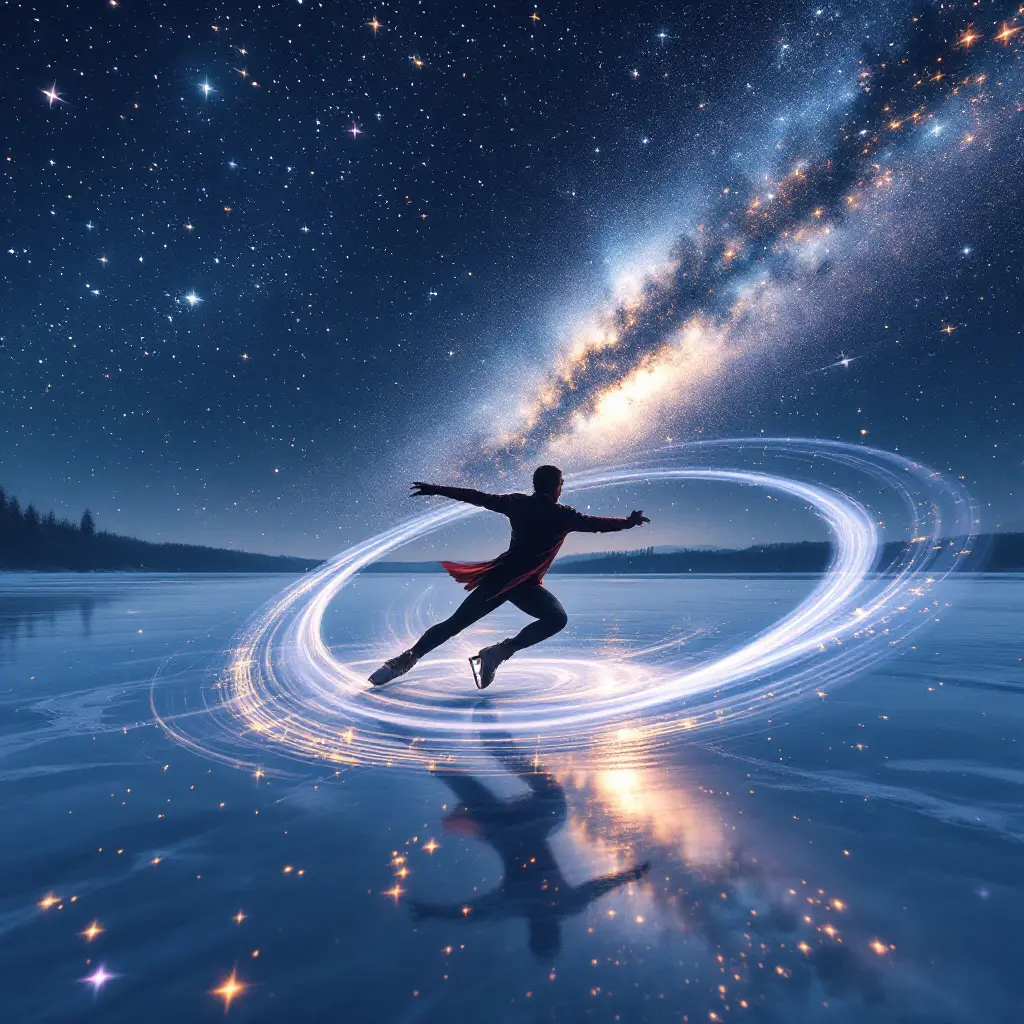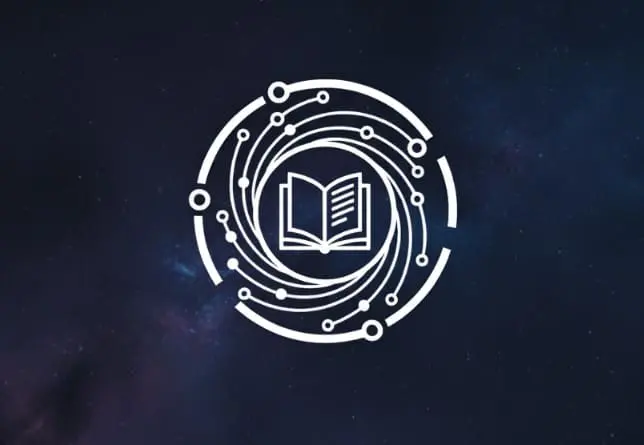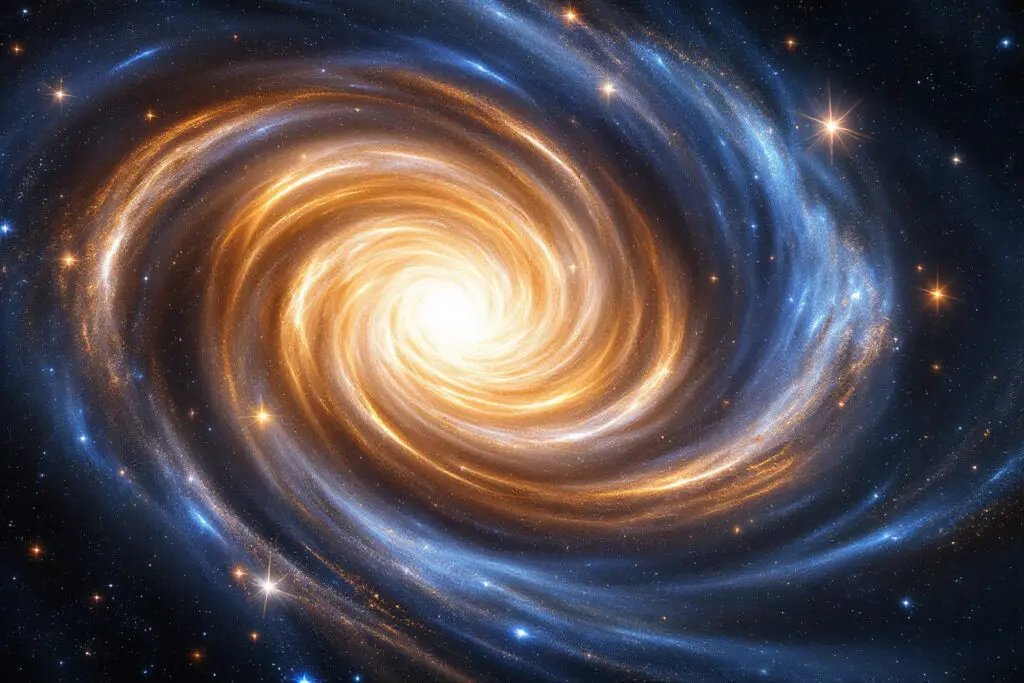Have you ever watched an ice skater mid-spin, arms outstretched, and then witnessed the sudden, breathtaking acceleration as they pull their arms in? It’s a moment of pure magic. A human transformation into a blur. But it’s not magic at all. That simple, elegant action is a perfect demonstration of a law that governs the entire universe. It’s the same rule that flattens galaxies into majestic spirals, that forges stars and planets from shapeless clouds of dust, and that locks our own world into a stable, life-sustaining orbit. This powerful, invisible architect is the conservation of angular momentum in space.
It’s one of the most fundamental principles in all of physics, and it’s the reason the cosmos is a dynamic, swirling, endlessly fascinating dance rather than a static, boring expanse. From the delicate rings of Saturn to the violent birth of a black hole, this one concept is the master choreographer. It’s why we have a day and night, why a quarterback’s pass flies true, and why our solar system hasn’t spun apart or collapsed into the Sun.
To understand it is to hold a key to some of the deepest secrets of the universe.
More in Celestial Mechanics Category
How Orbital Eccentricity Shapes Orbits
Key Takeaways
- What is Angular Momentum?: Think of it as “spin energy.” It’s the measure of an object’s inherent tendency to keep rotating. The exact amount depends on three things: its mass, how fast it’s spinning, and—most importantly—how that mass is spread out.
- The Law of Conservation: In any isolated system, the total angular momentum can never change. It’s a constant. If an object rearranges itself by pulling its mass closer to the center of rotation (like our skater), it must spin faster to keep the total momentum the same.
- Cosmic Importance: This single law dictates the flat, disk-like shape of most galaxies, drives the formation of stars and solar systems, and ensures the stability of planetary orbits over billions of years.
- Everyday Examples: You can see this cosmic law at work all around you. It’s in a child’s spinning top, a spiraling football, and a diver tucking into a ball to complete a flip before hitting the water.
So, What Exactly Is This ‘Spin’ That Governs the Cosmos?
Let’s really get a feel for this. Imagine you’re swinging a ball on a rope around your head. That ball has angular momentum. It’s a property that anything rotating or revolving around a central point possesses. But it isn’t just about raw speed. It’s a combination of three distinct factors. First, mass—a heavier ball has more. Second, velocity—a faster ball has more. And third, the radius, or how the mass is distributed.
This third part is the secret sauce. The further the mass is from the center, the more “leverage” it has, and the more angular momentum it carries, even at the same speed. That ball on a long rope has far more angular momentum than the same ball on a short rope spinning at the same clip. This resistance to change in rotation is called “rotational inertia.” An object with its mass spread out wide has high rotational inertia; it’s hard to get it spinning, and once it is, it’s hard to stop. It’s like trying to push open a heavy gate near the hinges versus near the latch—the leverage makes all the difference.
So, angular momentum isn’t just spin. It’s the product of an object’s rotational inertia and its rotational speed.
Why Is It a “Conserved” Quantity?
Here’s where things get really interesting. The universe has a few rules that it never, ever breaks. The conservation of angular momentum is one of them. It means that for any spinning system, if you don’t interfere with it from the outside, its total angular momentum will remain absolutely constant.
Forever.
This is the ice skater principle in its purest form. When her arms are out, her mass is spread wide, giving her high rotational inertia. To maintain her angular momentum, she spins at a certain speed. But the moment she pulls her arms in, her mass is concentrated near her body. Her rotational inertia plummets. Since the universe demands that her total angular momentum stay the same, there’s only one way to balance the equation: her rotational speed has to skyrocket. The result is that stunning, seemingly impossible acceleration.
This isn’t a trick; it’s physics. The cosmos is full of these “isolated systems” where no external twisting forces, or “torques,” are acting. In these systems, from a lonely asteroid tumbling through the void to an entire galaxy, angular momentum is the one value that is stubbornly, reliably preserved.
How Did This Principle Shape Our Solar System?
Our solar system was born from chaos. Around 4.6 billion years ago, it was nothing more than a colossal, shapeless cloud of gas and dust—a solar nebula. It was unimaginably vast, cold, and dark. But it wasn’t perfectly still. The cumulative effect of tiny, random motions gave the whole cloud a very slow, almost imperceptible rotation. Given its enormous size, this slight spin endowed it with a tremendous amount of total angular momentum.
Then gravity took over. The cloud began to collapse in on itself. As particles of dust and gas were pulled inward, they drew closer to the center of rotation. Do you see it? The ice skater was getting ready to pull in her arms. As the cloud shrank, its rate of spin had to increase dramatically to conserve that initial angular momentum. This acceleration had a profound, system-defining consequence. It created a powerful centrifugal force that pushed outward, opposing gravity’s inward crush.
The material couldn’t just fall straight into the growing proto-sun at the center. Instead, the relentless spinning flattened the collapsing cloud into a vast, rotating platter called a protoplanetary disk. It’s the exact same reason spinning a ball of pizza dough flattens it into a perfect circle. This is why all the planets in our solar system orbit the Sun in the same direction and on roughly the same flat plane. We are living on a leftover piece of that cosmic pizza.
What Does Angular Momentum Have to Do with Planet Formation?
Inside that spinning disk, the real magic began. The conditions were just right for planet building. Tiny grains of dust, coated in ice, began to gently bump into each other and stick together. This process, called accretion, built pebbles, then rocks, then city-sized “planetesimals.” Since everything in the disk was already orbiting the young Sun, these building blocks all carried their own angular momentum.
Their orbits were the direct inheritance of the disk’s spin. As these planetesimals grew, their gravitational pulls increased, and they began to sweep up material in their path. Collisions were frequent and transformative. When planetesimals merged, their angular momenta combined, building larger and larger bodies. This momentum was expressed in two key ways for the newly forming planets:
- Orbital Angular Momentum: This is the momentum of a planet’s motion as it revolves around the Sun. It’s what keeps Earth trapped in a stable, predictable path, preventing it from flying off into deep space or spiraling into the Sun.
- Spin Angular Momentum: This is the momentum of a planet’s rotation on its own axis. This spin is an echo of the countless off-center collisions that formed it, and it’s what gives us the familiar cycle of day and night.
The entire elegant process, from a diffuse cloud to a star surrounded by an orderly family of planets, is a direct result of angular momentum in space.
Can Angular Momentum Explain the Bizarre Tilts of Planets?
It certainly can. The basic formation process explains the general order of the solar system, but it doesn’t account for the wonderful weirdness we see. Take Uranus. It’s knocked over on its side, with an axial tilt of 98 degrees, effectively rolling along its orbit. Venus is even stranger; it spins backward, a phenomenon known as retrograde rotation.
What could have happened? The early solar system was a violent, crowded shooting gallery. The answer almost certainly lies in titanic collisions. Imagine a young, spinning proto-Earth being dealt a glancing blow by another protoplanet the size of Mars. An impact of that magnitude would be unimaginable. It would not just add mass; it would inject a colossal amount of new angular momentum into the system, violently altering Earth’s original spin axis and speed.
This is, in fact, the leading theory for the formation of our own Moon. A massive impact is thought to have knocked our planet to its current 23.5-degree tilt, creating the seasons, and blasted a huge cloud of debris into orbit that eventually coalesced into our lunar companion. The unique spin and tilt of every planet is a battle scar—a historical record of the chaos it survived.
How Does This Force Sculpt Entire Galaxies?
The rules don’t change just because the scale gets bigger. Galaxies, like our Milky Way, are born from even more immense clouds of primordial gas. And just like the solar nebula, these clouds had a slight initial rotation. As gravity began to pull the material together over hundreds of millions of years, the cloud contracted and began to spin faster and faster.
This conserved angular momentum is the single biggest reason why so many galaxies have that iconic, beautiful spiral disk shape. The rapid rotation flattens the material into a plane, preventing it from simply collapsing into a giant, spherical ball of stars. Stars are born from the gas within this spinning disk, and they inherit its angular momentum, continuing to orbit the galactic center in a delicate dance between gravity’s inward pull and their own orbital motion. Without angular momentum, the majestic spiral structures we see across the universe wouldn’t exist. The night sky would be filled with far less interesting fuzzy blobs.
What Happens When Stars Die?
Angular momentum doesn’t just build things; it also orchestrates some of the most spectacular destruction in the cosmos. Consider a star much more massive than our Sun. After millions of years, it exhausts its nuclear fuel. The outward pressure from fusion ceases, and the star’s enormous core collapses under its own crushing gravity, triggering a supernova explosion.
This collapse is the most extreme version of the ice skater imaginable. The star’s core might shrink from a million miles across to just ten miles across in a matter of seconds. To conserve its angular momentum, its spin rate must increase to an almost unbelievable degree.
The core can become a neutron star—an object so dense that a single teaspoon of it would outweigh Mount Everest. These stellar remnants can spin hundreds of times every second. They are cosmic flywheels, the angular momentum of a giant star now trapped in an object the size of a city. Some of these, known as pulsars, blast beams of radiation from their magnetic poles, which sweep across space like a lighthouse beam—a directly observable consequence of this incredible spin-up.
Could Black Holes Exist Without Angular Momentum?
For the absolute most massive stars, not even the physics of neutron stars can halt the final collapse. Gravity wins completely. The core collapses indefinitely, punching a hole in the fabric of spacetime itself to become a black hole. And just like its parent star, it spins.
A spinning black hole is where physics gets truly weird. The rotation is so extreme that it literally twists the fabric of spacetime around with it, a phenomenon called “frame-dragging.” Imagine a bowling ball spinning in a vat of thick honey; it drags the honey around with it. A spinning black hole does that to space and time. This creates a region outside the event horizon called the ergosphere, where nothing can stand still.
You are forced to move with the flow of spacetime. The angular momentum of the dead star becomes a fundamental property of the black hole, and it powers some of the most energetic phenomena in the universe, like the colossal jets of plasma that are often seen blasting away from the poles of active black holes at near the speed of light.
How Do We Use This Principle for Space Exploration?
We have learned to be cosmic ice skaters ourselves. When NASA launches a probe to Mars or Jupiter, they aren’t just aiming and shooting. They are placing the spacecraft into a precise orbit where its orbital angular momentum will carry it on a predictable path, allowing it to coast through the solar system with minimal fuel.
Engineers also use a brilliant application of this law to aim spacecraft with incredible precision. Inside probes like the Hubble Space Telescope or the James Webb, there are devices called control moment gyroscopes, which are essentially heavy, fast-spinning flywheels.
- To turn the telescope left, an internal motor makes a flywheel spin faster to the right.
- Since the total angular momentum of the whole system (telescope + wheel) must be conserved, the telescope itself must rotate to the left to compensate.
- By controlling the speeds of several of these wheels, operators can point the telescope with microscopic accuracy, all without firing thrusters that would waste fuel and jiggle the view.
This technique, called attitude control, is fundamental to modern space exploration. As confirmed by the experts at NASA, it’s a beautifully elegant solution that uses a core law of the universe to navigate the void.
Is Angular Momentum Truly Everywhere?
Yes. Once you know what to look for, you see it everywhere. It’s in the tight spiral a quarterback puts on a football to stabilize its flight. It’s in the way a high-diver pulls into a tuck to spin faster. A child on a playground merry-go-round learns that if they crawl toward the center, it spins faster. A cat, when dropped upside down, instinctively twists its body in different directions—conserving its zero angular momentum—to ensure it lands on its feet.
From the swirling of weather patterns on Earth to the grand dance of galaxies, this principle is woven into the very fabric of reality. It’s a simple rule with consequences so profound that it has shaped our entire universe. It is the silent architect and the unseen choreographer. The next time you look up at the Moon held in its steady orbit, remember the incredible cosmic spin that keeps it all in motion.
FAQ – Angular Momentum in Space

Why do some planets, like Uranus and Venus, have unusual tilts or rotations, and how does angular momentum explain this?
Unusual tilts and rotations of planets, such as Uranus’s 98-degree tilt or Venus’s retrograde spin, are caused by massive impacts and collisions during the chaotic early history of the solar system. These impacts impart additional angular momentum or alter the spin axes, leaving the planets with their distinctive tilts and rotations, which are traces of their tumultuous past.
In what way did angular momentum shape the formation of our solar system?
The solar system formed from a rotating cloud of gas and dust that collapsed under gravity. As it shrank, its rotation sped up due to conservation of angular momentum, causing the cloud to flatten into a disk-shaped protoplanetary system. This process led to the formation of planets orbiting in the same direction and on a roughly flat plane, inherited from the initial spinning cloud.
What exactly is angular momentum and why is it important in the universe?
Angular momentum is a measure of an object’s tendency to keep spinning or rotating, depending on its mass, how fast it spins, and how that mass is distributed. It is important because it governs the behavior of celestial bodies and systems, causing galaxies to have spiral shapes, planets to orbit stars, and ensuring the stability of orbits over billions of years.

